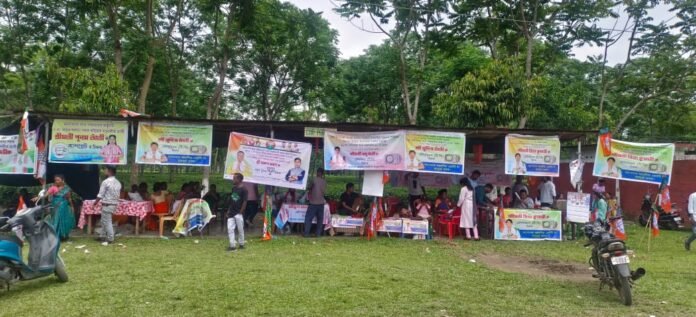Tinsukia (Doomdooma):
Two Brothers, One Struggle
As Assam votes in the first phase of its Panchayat elections, the ground reality in many parts of the state reveals a sobering disconnect between electoral promises and everyday life.
In upper Assam’s Tinsukia district, two brothers—Ganpat and Gajindar, residents of Doomdooma—were spotted foraging for dhekia haak (wild fiddlehead ferns) from roadside bushes near the Beesakopie Mazdoor Club polling booth, instead of preparing for the vote.
“We had leftover rice in the morning. Now we’re plucking vegetables to cook. We’ll vote after lunch—but we’ve lost hope in both the ‘Boro Sorkar’ (central government) and the ‘Chhoto Sorkar’ (state government),” Ganpat told BorokTimes.
Both men belong to the Tea Tribes community, an influential yet underserved population in Assam, often critical to electoral outcomes but rarely beneficiaries of policy.
Doomdooma: Tea City with Fraying Faith
Doomdooma, a sub-division in Tinsukia district, lies 24 km from Tinsukia HQ, 524 km from Guwahati, and 2,411 km from Delhi. Bordering Arunachal Pradesh, it is one of Assam’s remotest regions—culturally rich but economically stagnant.
Despite its strategic location and voter base, frustration is high. As elections unfold across 15 districts in this phase—including Tinsukia, Dibrugarh, Majuli, and Sivasagar—many voices echo a similar narrative: disillusionment.
No Real Progress for Tea Tribes
Rosika Das, a local school teacher, stood in line to cast her vote under an umbrella in the scorching afternoon.
“Our people helped form governments in Dispur and Delhi. Yet, we still battle poverty, unemployment, and inflation. No significant change has come to our community,” she said.
The BJP first came to power in Assam in 2016 under Sarbananda Sonowal, and remains in office under Himanta Biswa Sarma since 2021. Nationally, the party has governed since May 2014.
Cost of Living and Crushed Hopes
For many, day-to-day survival has become harder.
“Wheat flour and rice now cost ₹50/kg. Vegetables and pulses are over ₹100. Gas cylinders are at a record high. Add to that the mishandling during COVID and the impact of demonetization. People are broken,” said Ranjana, a senior citizen who came to vote in a wheelchair.
She also raised concerns about rising medicine costs, something she says has become unbearable for the elderly and poor.
What’s Next in Assam’s Electoral Story
This year’s Panchayat polls are being watched closely by analysts and political observers, as they may offer early indicators for the 2026 Assembly elections.
The second phase of polling is set for May 7 across 13 districts, including Dhubri, South Salmara-Mankachar, Kamrup, Nagaon, and others.
It’s important to note that the Sixth Schedule regions, including the hill districts and Bodoland Territorial Region (BTR), are excluded from the Panchayati Raj system.
Counting of votes is scheduled for May 11.
Conclusion
As India’s democracy plays out in polling booths, the story of Ganpat and Gajindar is a reminder that elections are not just about ballots—but also about broken promises, survival struggles, and voices from the margins asking, “Will it ever change?”




